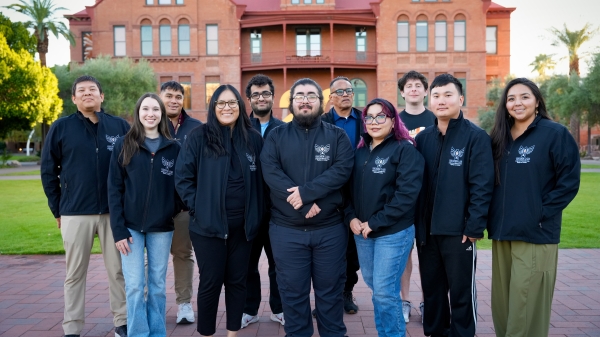Cosmic clues: Metal-poor regions unveil potential method for galaxy growth

An artist's conception of a galaxy with gas clouds of varying amounts of metals. The color of the clouds, from dark blue to purple to light blue to white, indicates a decrease in the amount of metals that make up the gas cloud. Image courtesy of ASU: Olvera/Dooling
For decades, astronomers have analyzed data from space and ground telescopes to learn more about galaxies in the universe. Understanding how galaxies behave in metal-poor regions could play a crucial role in understanding how galaxies form and evolve.
However, the presence of metals in a galaxy's gas and dust, typically formed through star deaths and supernovae, provides valuable clues about its history.
This component has identified areas of the spiral galaxy NGC 99 that contain unexpectedly low levels of metals — elements heavier than hydrogen and helium. This influx of gas could play a key role in reshaping the structure and evolution of galaxies, and is the subject of a recent study by a team of scientists led by Alejandro Olvera, with Sanchayeeta Borthakur, Mansi Padave, Rolf Jansen, Brad Koplitz and Timothy Heckman of Arizona State University's School of Earth and Space Exploration. The results of their study have been recently published in the Astrophysical Journal.
While the concept of metal-poor gas inflows contributing to galaxy growth has been suggested in the past, direct observational evidence has been scarce. The team's recent discoveries provide robust support for this theory, representing a significant leap in our comprehension of galaxy life cycles.
“My approach to this research is as a detective approaches a crime scene. Since directly observing gas falling into galaxies is challenging, we rely on indirect evidence and retrace the sequence of events that produced these observations” said Olvera, graduate associate in the School of Earth and Space Exploration. “The key to solving this mystery lies in the galaxy’s chemical abundance pattern. By piecing together clues on our evidence wall and conducting thorough analyses, we conclude that the metal-poor regions we observe most likely result from metal-poor gas streaming into the galaxy from beyond the galactic disk.”
"The discovery of the gas inflow and how it could fuel star formation and change galaxies' chemical makeup and structure over time opens up new possibilities for understanding how galaxies like the Milky Way and NGC 99 continue to form stars and grow,” said Sanchayeeta Borthakur, associate professor in the School of Earth and Space. “This research enhances researchers' understanding of galaxy evolution and paves the way for further exploration into the hidden mechanisms that shape the universe on a large scale."
Olvera's research is supported by the National Science Foundation's Graduate Research Fellowship Program and through NSF awards 2009409 and 2108159 to Borthakur. The study relies on data collected from several advanced instruments, including the MMT Telescope (a 6.5-meter telescope located in Arizona), the Very Large Array radio telescope, the Hubble Space Telescope for ultraviolet (UV) observations and the Vatican Advanced Technology Telescope.
The research team hopes that future studies will build upon these findings, using even more advanced technology to explore metal-poor regions in other galaxies and expand our understanding of how galaxies evolve across cosmic time.
“With results from this work, we have firmly established that, even today, galaxies like ours are actively acquiring gas to form new stars," Olvera said. "The techniques highlighted in this work will revolutionize our understanding of how galaxies grow and will be applicable for those nearby as well as those billions of light-years away.”
More Science and technology

Indigenous geneticists build unprecedented research community at ASU
When Krystal Tsosie (Diné) was an undergraduate at Arizona State University, there were no Indigenous faculty she could look to in any science department. In 2022, after getting her PhD in genomics…

Pioneering professor of cultural evolution pens essays for leading academic journals
When Robert Boyd wrote his 1985 book “Culture and the Evolutionary Process,” cultural evolution was not considered a true scientific topic. But over the past half-century, human culture and cultural…

Lucy's lasting legacy: Donald Johanson reflects on the discovery of a lifetime
Fifty years ago, in the dusty hills of Hadar, Ethiopia, a young paleoanthropologist, Donald Johanson, discovered what would become one of the most famous fossil skeletons of our lifetime — the 3.2…